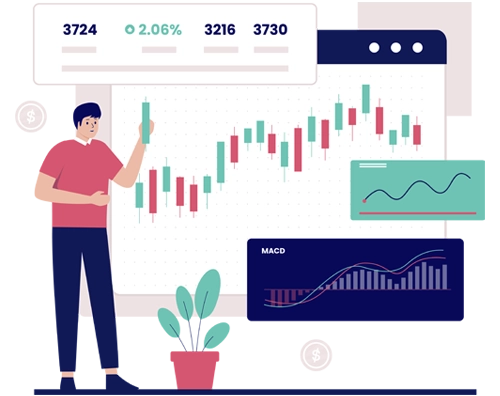day trading vs. long-term investing. Each strategy comes with its own set of advantages and risks, and finding the right balance can be the key to success in a Robinhood-like environment.
The choice between day trading and long-term investing represents a pivotal decision for individuals navigating the dynamic landscape of a Robinhood-like trading environment. These two strategies each offer a distinct set of advantages and risks, and understanding their nuances is essential for achieving success in today’s fast-paced financial markets.
Day Trading: Day trading involves making frequent and often rapid trades within a single trading day. It capitalizes on short-term price fluctuations, aiming to profit from intraday volatility. One of the key advantages of day trading is the potential for quick gains. Traders can capitalize on price movements over a matter of minutes or hours, and in a platform like Robinhood, this agility can be a significant asset. However, day trading also comes with substantial risks, including high volatility, the potential for substantial losses, and the mental and emotional stress of making rapid decisions.
Long-Term Investing: In contrast, long-term investing is a strategy focused on holding assets for an extended period, often years or decades. This approach seeks to capitalize on the potential for long-term growth in the value of investments. The advantages of long-term investing include reduced stress, the potential for compounding returns, and historically consistent market growth over time. However, this strategy requires patience and discipline, as it may take years to realize significant gains. In a Robinhood-like environment, where the temptation to make frequent trades is high, sticking to a long-term investment plan can be particularly challenging.
Finding the Right Balance: The key to success in a Robinhood-like environment lies in finding the right balance between these two strategies. While day trading may offer opportunities for quick profits, it can also lead to significant losses if not executed with care. On the other hand, adopting a long-term investment mindset can provide stability and the potential for substantial wealth accumulation over time. Striking a balance may involve allocating a portion of your portfolio to short-term trading while maintaining a core of long-term investments that align with your financial goals and risk tolerance.
Moreover, it’s essential to remember that both strategies require continuous learning and adaptability. The financial markets are ever-evolving, and what works today may not work tomorrow. Staying informed, practicing risk management, and having a well-defined trading or investment plan are critical regardless of your chosen approach.
In conclusion, the decision between day trading and long-term investing in a Robinhood-like environment is not an either-or proposition; it’s about finding the right blend that aligns with your financial objectives and risk tolerance. By carefully considering the advantages and risks of each strategy and by maintaining a disciplined approach to your chosen path, you can navigate the complexities of today’s trading landscape with confidence and greater potential for success.
If you’d like to dive deeper into this subject, there’s more to discover on this page: The future of banking: A $20 trillion opportunity | McKinsey

Day trading is the art of buying and selling financial instruments within the same trading day, aiming to profit from short-term price fluctuations. It’s the high-octane world of traders glued to their screens, making quick decisions, and capitalizing on minute price movements. Day trading in a Robinhood-like environment offers several attractions:
Day trading is an exhilarating pursuit, akin to a fast-paced chess match played out on the stock market battlefield. It’s a realm where traders are constantly glued to their screens, poised to execute rapid-fire buy and sell orders, all with the ultimate goal of capitalizing on the slightest price gyrations within a single trading day.
In today’s landscape, where commission-free trading platforms like Robinhood have democratized access to the markets, day trading has gained even more allure. Here are some of the key attractions and advantages of day trading in a Robinhood-like environment:
Accessibility: Robinhood and similar platforms have shattered the traditional barriers to entry. They provide easy access to the stock market, allowing traders with limited capital to participate actively. With no commissions to worry about, you can execute multiple trades throughout the day without incurring high costs.
Low Capital Requirements: Day trading doesn’t necessitate a vast amount of capital. Thanks to the availability of fractional shares on platforms like Robinhood, you can start trading with relatively small amounts of money. This accessibility enables traders to test their strategies and gain experience without risking substantial funds.
Real-Time Data and Analysis: Day traders rely heavily on real-time market data and technical analysis. Robinhood offers user-friendly interfaces that provide real-time stock prices, charts, and other essential information. This accessibility to data empowers traders to make informed decisions swiftly.
Quick Execution: Speed is paramount in day trading, and Robinhood-like platforms offer quick order execution. With just a few taps on your smartphone, you can enter and exit positions swiftly, taking advantage of fleeting market opportunities.
Diverse Asset Classes: While equities are a common choice for day traders, platforms like Robinhood also offer access to other asset classes like options and cryptocurrencies. This diversity enables traders to explore various markets and trading instruments.
Community and Learning: Robinhood communities and similar platforms often feature social components, allowing traders to share insights, experiences, and strategies. Learning from others and staying connected to the trading community can be invaluable for traders looking to refine their skills.
Risk Management: Successful day trading hinges on effective risk management. Many Robinhood-like platforms offer risk management tools and features, such as setting stop-loss orders and defining risk levels for each trade.
However, it’s essential to remember that day trading is not without its risks. The fast-paced nature of day trading can be mentally and emotionally taxing, and novice traders may experience significant losses if not adequately prepared. It’s crucial to approach day trading with a well-thought-out strategy, discipline, and a clear understanding of the risks involved. While the attractions of day trading in a Robinhood-like environment are alluring, they are best harnessed by traders who are prepared to invest the time and effort needed to navigate this demanding and dynamic realm effectively.
Explore this link for a more extensive examination of the topic: Jeff Yass: The Billionaire GOP Mega-Donor Gaming the Tax System …

Robinhood’s commission-free model has made it easier than ever for aspiring day traders to start. With no trading fees, even small investors can participate.
Robinhood’s commission-free model represents a democratization of financial markets that has transformed the landscape of day trading and investing. Let’s delve deeper into how this innovation has ushered in a new era of accessibility and opportunity for aspiring traders:
Removing Barriers to Entry: Robinhood’s commission-free trading model has essentially removed the financial barrier that once restricted many individuals from participating in the stock market. This means that even those with limited capital can now engage actively in trading and investing, fostering financial inclusivity.
Accessible Learning Ground: The absence of trading fees means that novice traders can experiment and learn without incurring substantial costs. It serves as a low-risk training ground for those who wish to hone their skills and gain experience in the intricate world of trading.
Empowering Small Investors: Robinhood’s commission-free approach empowers small investors by allowing them to make trades that might have been economically unfeasible with traditional brokers. These investors can build diversified portfolios with fewer constraints, harnessing the potential for growth over time.
Risk Management: With no trading fees eating into profits, traders have the flexibility to manage their positions more efficiently. They can enter and exit trades without worrying about the impact of fees on their overall returns, making it easier to implement risk management strategies.
Promoting Active Engagement: The commission-free model encourages more active engagement with the stock market. Traders can execute frequent trades, explore various trading strategies, and adapt to changing market conditions without the hindrance of fees, all of which can contribute to a deeper understanding of market dynamics.
Market Accessibility: The ease of trading with Robinhood means that investors can access a wide range of securities, including stocks, options, exchange-traded funds (ETFs), and cryptocurrencies. This diversification potential allows investors to tailor their portfolios to align with their risk tolerance and investment objectives.
Investor Education: Robinhood places a strong emphasis on investor education, providing resources and tools to help traders make informed decisions. This commitment to financial literacy empowers users to navigate the markets confidently and responsibly.
Innovation Catalyst: Robinhood’s success has sparked innovation in the brokerage industry, with many traditional brokers also adopting commission-free models. This competition benefits consumers by offering a wider array of options for commission-free trading, ultimately driving down costs and improving services.
Market Participation: The commission-free model has contributed to a surge in retail trading activity, with more individuals actively participating in financial markets. This increased retail presence has had notable impacts on market dynamics and has brought individual investors into the spotlight.
In conclusion, Robinhood’s commission-free model has revolutionized the financial industry, making it easier and more accessible for aspiring day traders and investors to enter the market. It has empowered individuals to take control of their financial futures, provided a platform for learning and growth, and reshaped the way we think about investing in the digital age. However, it’s essential to remember that while commission-free trading offers many advantages, it also comes with responsibilities, including risk management and ongoing education, to ensure responsible and informed trading practices.
Looking for more insights? You’ll find them right here in our extended coverage: Who Wins a Brokerage Price War?

Robinhood and similar platforms provide real-time market data and news, allowing day traders to make informed decisions rapidly.
Robinhood and similar trading platforms have revolutionized the way day traders operate by delivering real-time market data and news at their fingertips. Here’s an extended look at the significance of this feature and how it influences the world of day trading:
Timely Decision-Making: Real-time market data and news are the lifeblood of day trading. They empower traders to make quick and well-informed decisions as market conditions change. Whether it’s monitoring price movements, volume trends, or breaking news, having access to up-to-the-minute information is crucial.
Volatility Management: Day traders often thrive on market volatility, but it can also pose significant risks. Real-time data helps traders monitor volatility levels and adjust their strategies accordingly. They can identify potential entry and exit points, set stop-loss orders, and stay agile in response to market fluctuations.
Technical Analysis: Technical analysis is a cornerstone of day trading, and real-time data is essential for this approach. Traders use live charts, indicators, and price patterns to identify trends and make predictions about future price movements. Real-time data ensures that their technical analysis is based on the most current information.
News Catalysts: Market news can act as a catalyst for rapid price changes. Real-time news feeds allow day traders to react swiftly to breaking news, earnings reports, economic indicators, and geopolitical events that can impact asset prices. This responsiveness can be a key driver of success in day trading.
Intraday Strategies: Many day trading strategies rely on intraday price fluctuations. Real-time data enables traders to implement strategies like scalping, momentum trading, and gap trading, where quick execution based on current data can make the difference between profit and loss.
Risk Management: Effective risk management is vital in day trading, and real-time data plays a central role. Traders can monitor their positions and account balances in real time, helping them set and adjust risk parameters such as position size and stop-loss levels.
Trade Execution: Speed is of the essence in day trading, and real-time data ensures that orders are executed promptly and accurately. Traders can enter and exit positions with confidence, knowing that they are acting on the most recent information available.
Adaptability: Markets can change rapidly, and real-time data allows day traders to adapt to shifting conditions. Whether it’s spotting opportunities for short-term reversals, breakout trades, or trend following, real-time data is indispensable for staying ahead of the market.
Psychological Factors: Real-time data can also impact the psychology of trading. It provides traders with a constant flow of information, which can affect emotions like fear and greed. Successful day traders must develop discipline and emotional resilience to make rational decisions in the face of rapid market changes.
Continuous Learning: Real-time data exposes day traders to a dynamic learning environment. As they actively engage with live market conditions, traders can refine their strategies, adapt to different asset classes, and develop a deeper understanding of market behavior.
In summary, real-time market data and news are the backbone of day trading on platforms like Robinhood. They enable traders to stay informed, manage risk, and execute trades swiftly and efficiently. This real-time access to information empowers day traders to navigate the fast-paced world of intraday trading and capitalize on short-term market opportunities.
To delve further into this matter, we encourage you to check out the additional resources provided here: Robinhood Reports Fourth Quarter and Full Year 2021 Results …

Highly liquid markets enable quick execution of trades, ensuring that day traders can enter and exit positions without significant slippage.
Highly liquid markets, often characterized by a high volume of trading activity and a tight bid-ask spread, offer day traders several advantages that contribute to their ability to execute trades swiftly and efficiently. This liquidity can be attributed to the presence of a large number of buyers and sellers actively participating in the market. Here’s an extension of why liquidity is crucial for day traders:
1. Price Efficiency: Liquidity ensures that prices in highly liquid markets accurately reflect the underlying supply and demand dynamics. This means that the prices you see on your screen are more likely to be a true reflection of the asset’s value, reducing the risk of executing trades at unfavorable prices. For day traders, this is paramount, as they rely on precise entry and exit points to maximize profits and minimize losses.
2. Narrow Bid-Ask Spread: In liquid markets, the bid-ask spread—the difference between the highest price a buyer is willing to pay (bid) and the lowest price a seller is willing to accept (ask)—is typically narrow. This tight spread reduces the cost of trading, as day traders can buy at the ask price and sell at the bid price, narrowing the gap between these two prices. In contrast, illiquid markets often have wider spreads, which can erode profits.
3. Reduced Slippage: Slippage occurs when the execution price of a trade differs from the expected price at the time of order placement. In highly liquid markets, slippage is generally minimal because there are ample buyers and sellers, reducing the chances of orders being filled at undesirable prices. This is especially crucial for day traders, as even small slippages can significantly impact their profitability.
4. Flexibility and Scalability: Liquid markets allow day traders to easily scale their positions up or down without causing substantial price fluctuations. They can enter and exit positions with larger sizes, taking advantage of short-term price movements while maintaining control over their trades.
5. Real-Time Information: In liquid markets, real-time price and volume information is readily available, ensuring that day traders have access to up-to-the-second data. This allows for quick decision-making and immediate reactions to market developments, enhancing the trader’s ability to capitalize on opportunities.
6. Lower Capital Requirements: Given the ease of entering and exiting positions in highly liquid markets, day traders may require less capital compared to illiquid markets, where larger position sizes might be necessary to offset the wider bid-ask spreads and the risk of limited buyers or sellers.
7. Risk Mitigation: Liquidity can act as a risk mitigator. In the event of unexpected news or market shocks, day traders in liquid markets have a better chance of executing stop-loss orders at or near their intended prices, limiting potential losses.
In summary, the presence of liquidity in a market is a significant boon for day traders. It provides them with the tools they need to execute their strategies efficiently, manage risk, and make timely decisions. However, it’s important to note that with greater liquidity often comes increased competition, so day traders must still exercise caution, employ sound risk management practices, and stay well-informed about market conditions to succeed in this fast-paced environment.
To expand your knowledge on this subject, make sure to read on at this location: What is Furniture, Fixtures, and Equipment (FF&E)?

The fast-paced nature of day trading can be emotionally and mentally taxing. Constant monitoring of positions and rapid decision-making can lead to stress and burnout.
Day trading, characterized by its rapid pace and constant decision-making, indeed demands a toll on traders’ emotional and mental well-being. Here’s an extended perspective on the challenges and strategies for managing stress and avoiding burnout in this high-intensity trading style:
Emotional Rollercoaster: Day trading can be an emotional rollercoaster. The adrenaline rush from quick gains can be exhilarating, but it’s often followed by the frustration of losses. It’s crucial for day traders to cultivate emotional resilience and avoid making impulsive decisions based on emotions.
Stress Management: Stress is an inherent part of day trading. Traders face market volatility, uncertainty, and the pressure to perform. Implementing stress management techniques, such as meditation, exercise, or time away from the screens, can help maintain mental equilibrium.
Setting Clear Limits: Establishing clear boundaries is essential. Day traders should set daily and weekly limits on losses and gains. When these limits are reached, it’s vital to step away from trading to prevent impulsive actions that could exacerbate losses.
Continuous Learning: The day trading landscape is ever-changing. Continuous learning, staying updated on market news, and fine-tuning trading strategies are essential. Knowledge can empower traders to make more informed decisions, reducing anxiety associated with uncertainty.
Risk Management: Effective risk management is the foundation of day trading success. Traders should employ stop-loss orders and position sizing to limit potential losses. By implementing sound risk management practices, traders can reduce the emotional impact of losses.
Trade Planning: Having a well-thought-out trading plan is crucial. This plan should include entry and exit points, risk-reward ratios, and a clear strategy. Following a plan reduces the need for impulsive decision-making, which can lead to stress.
Routine and Discipline: Establishing a daily routine and adhering to it can provide structure and discipline in the world of day trading. A structured approach can help traders remain focused and avoid burnout by ensuring a work-life balance.
Support Systems: Day traders should seek support from peers or mentors. Discussing challenges and sharing experiences with others in the trading community can provide emotional support and fresh perspectives.
Trading Psychology: Understanding trading psychology is crucial. The study of behavioral finance can shed light on common biases and cognitive traps that lead to emotional decisions. Awareness of these pitfalls can help traders avoid them.
Diversification: Overreliance on a single trading strategy or asset class can exacerbate stress. Diversifying trading strategies and assets can spread risk and reduce the emotional burden associated with a single trade’s outcome.
Taking Breaks: Regular breaks during trading hours are essential. Stepping away from the screens for short intervals can refresh the mind and help maintain focus and composure.
Assessment and Adaptation: Periodically assess trading performance and strategies. If a particular strategy consistently leads to stress or losses, be willing to adapt and evolve. Flexibility is a valuable trait in the fast-paced world of day trading.
In conclusion, day trading offers the potential for substantial gains but comes with inherent challenges that can strain emotional and mental well-being. To thrive in this environment, traders must prioritize self-care, discipline, risk management, and continuous learning. Striking a balance between the fast-paced nature of day trading and maintaining emotional and mental health is essential for long-term success and avoiding burnout.
Explore this link for a more extensive examination of the topic: Is Day Trading Worth It? 8 Reasons It’s A Bad Idea | White Coat …

Day traders often concentrate their portfolios in a few assets, increasing the risk associated with a single position.
Certainly, the concentration of portfolios in just a few assets is a common practice among day traders, but it’s crucial to understand the implications and considerations associated with this strategy:
Intensive Monitoring: Day traders who focus on a small number of assets can closely monitor and analyze those assets throughout the trading day. This intensive monitoring allows for quick decision-making, capitalizing on short-term price movements.
Specialization: Concentrating on a few assets enables day traders to become specialists in those markets. They can develop a deep understanding of the assets’ behavior, patterns, and drivers, which can be advantageous when making rapid trading decisions.
Risk Management: While concentrating in a few assets can increase risk, it also provides an opportunity for effective risk management. Traders can implement stop-loss orders and other risk mitigation strategies more efficiently when dealing with a limited number of positions.
Efficient Capital Allocation: By focusing on a select group of assets, day traders can allocate their capital more efficiently. They can commit substantial resources to each position, potentially amplifying gains if the trades move in their favor.
Emotional Control: Managing a concentrated portfolio demands discipline and emotional control. Traders must resist the temptation to overtrade or let emotions drive their decisions. Sticking to a well-defined strategy is crucial to success.
Diversification vs. Concentration: Day traders face the classic dilemma of diversification vs. concentration. Concentrating in a few assets can yield significant returns, but it also exposes traders to higher individual asset risk. Diversification, on the other hand, spreads risk but may limit profit potential.
Risk of Single-Asset Volatility: Concentrated portfolios are vulnerable to sudden and extreme price swings in a single asset. If the chosen asset experiences unexpected news or events, it can lead to substantial losses. Risk management strategies must be in place to mitigate this risk.
Adapting to Market Conditions: Day traders who concentrate their portfolios should be prepared to adapt to changing market conditions. This may involve swiftly shifting focus to different assets if market dynamics or volatility change.
Continuous Learning: Maintaining a concentrated portfolio requires ongoing learning and research. Traders must stay informed about developments that could impact their chosen assets and be ready to adjust their strategies accordingly.
Alternative Approaches: Some day traders prefer to maintain a balance between concentration and diversification. They may allocate a portion of their portfolio to a few high-conviction trades while diversifying the rest to manage overall risk.
Long-Term Sustainability: Concentrating a portfolio can yield significant short-term gains, but day traders should also consider the long-term sustainability of their approach. Over time, it’s essential to assess the performance and adapt the strategy as needed.
In conclusion, concentrating a portfolio in a few assets is a strategy often employed by day traders to capitalize on short-term price movements. While it can yield substantial returns, it also comes with increased risk and demands a high level of discipline, risk management, and continuous learning. Day traders should carefully assess their risk tolerance, market conditions, and objectives when deciding on the level of portfolio concentration that aligns with their trading style.
If you’d like to dive deeper into this subject, there’s more to discover on this page: What is a Portfolio? – 2023 – Robinhood

The ease of trading on platforms like Robinhood can tempt day traders to execute excessive trades, leading to higher transaction costs and potential losses.
The convenience and accessibility offered by trading platforms like Robinhood have certainly revolutionized the landscape of stock trading. However, this newfound ease of trading can be a double-edged sword, particularly for day traders. Let’s delve further into this idea:
Overtrading and Transaction Costs: The ease of executing trades at the click of a button can tempt day traders to become overly active in the market. They may engage in excessive buying and selling, often referred to as “overtrading.” This frequent trading not only incurs transaction costs, such as commissions or spreads but also increases the potential for slippage, where trades are executed at prices less favorable than expected. These costs can eat into profits or exacerbate losses, especially for those who are not mindful of them.
Emotional Factors: Day trading can be emotionally taxing, and the ease of trading platforms can amplify emotional decision-making. It’s not uncommon for traders to become overly reactive to short-term market fluctuations, leading to impulsive trades based on fear or greed. This emotional rollercoaster can result in inconsistent trading performance and potential losses.
Lack of Strategy: Some day traders may jump into the market without a well-defined strategy or trading plan. The ease of trading can lead to a “shoot from the hip” approach, where traders make decisions without adequate analysis or consideration of risk management. This lack of strategy can be a recipe for financial disaster.
Short-Term Focus: Day trading often revolves around short-term price movements, which can overshadow a longer-term investment perspective. The constant monitoring of minute-to-minute price changes may lead day traders to neglect broader economic and market trends, missing out on valuable investment opportunities beyond the scope of daily trading.
Burnout: The fast-paced nature of day trading can lead to burnout, both mentally and physically. The constant monitoring of markets during trading hours can be exhausting, impacting decision-making and overall well-being.
Learning Curve: Day trading requires a deep understanding of technical analysis, chart patterns, and market indicators. The ease of access to trading platforms might lure individuals who are not adequately prepared, leading to steep learning curves and potential financial setbacks.
Regulatory Considerations: Day trading is subject to regulatory rules and requirements, including pattern day trader rules. Failing to adhere to these regulations can result in trading restrictions and penalties, further emphasizing the importance of informed and responsible trading.
Alternative Strategies: Instead of day trading, investors may consider alternative strategies such as swing trading or longer-term investing, which can reduce transaction costs, emotional stress, and the need for constant monitoring while still providing opportunities for profitable trades.
In conclusion, while platforms like Robinhood have democratized access to financial markets, they also come with challenges for day traders. The ease of trading can tempt traders into overactivity, emotional decision-making, and a lack of strategy. To navigate this environment successfully, day traders must prioritize discipline, risk management, and continuous education to make informed and responsible trading decisions.
If you’d like to dive deeper into this subject, there’s more to discover on this page: Attention Robinhood power users: Most day traders lose money

Long-term investing, on the other hand, involves buying and holding assets for an extended period, often measured in years or even decades. This strategy is the cornerstone of wealth accumulation for many investors and comes with its own set of advantages:
The Power of Patience: Embracing Long-Term Investing for Financial Success
Long-term investing represents a patient and strategic approach to wealth accumulation, and its benefits extend far beyond immediate gains. Let’s explore this approach more comprehensively:
1. Compound Growth Potential:
Long-term investing harnesses the remarkable power of compound growth. Over time, your investments can generate earnings, and these earnings, in turn, generate more earnings. This compounding effect can significantly amplify your wealth, especially over decades.
2. Riding Out Market Volatility:
Financial markets can be tumultuous in the short term, with fluctuations driven by various factors, including economic conditions, geopolitical events, and investor sentiment. Long-term investors are better equipped to weather these storms, knowing that market volatility tends to smooth out over extended periods.
3. Lower Transaction Costs:
Frequent buying and selling of assets incur transaction costs such as commissions and taxes. Long-term investors typically engage in fewer transactions, which reduces these costs, allowing more of their capital to remain invested and grow.
4. Tax Advantages:
Long-term capital gains are often subject to lower tax rates compared to short-term gains. By holding investments for an extended period, you may benefit from favorable tax treatment, leaving more of your returns in your pocket.
5. Psychological Benefits:
Constantly monitoring and trading assets can be emotionally taxing. Long-term investors experience less stress and anxiety associated with day-to-day market fluctuations. This psychological calm allows for more rational decision-making.
6. Reduced Timing Risks:
Timing the market—knowing when to buy and when to sell—is notoriously challenging. Long-term investors don’t need to worry about precisely when to enter or exit positions. They focus on the overall growth trajectory of their investments.
7. Flexibility and Life Goals:
Long-term investing aligns with a broader range of financial goals, whether it’s saving for retirement, funding a child’s education, or building generational wealth. It provides the flexibility to pursue a variety of aspirations.
8. Wealth Transfer and Legacy Building:
Long-term investing often transcends generations. Accumulated wealth can be passed down to heirs, providing financial security and opportunities for future family members.
9. Alignment with Business Cycles:
Many businesses and industries operate in cycles that span several years. Long-term investors who understand these cycles can strategically invest in assets that align with the upward trajectory of specific sectors.
10. Sustainability and Responsible Investing:
Long-term investors have the capacity to support sustainability and responsible investing practices. By committing to assets that align with their values and long-term objectives, they can contribute to positive societal and environmental change.
11. Continuous Learning and Adaptation:
Long-term investing isn’t static. It involves ongoing learning and adaptation to changing market conditions, economic trends, and investment opportunities. Staying informed and making strategic adjustments are integral to long-term success.
In conclusion, long-term investing is more than a strategy; it’s a mindset that embraces the potential of time and patience. By leveraging the benefits of compound growth, weathering market volatility, and enjoying various financial advantages, long-term investors position themselves for financial security and success that extends well into the future.
To delve further into this matter, we encourage you to check out the additional resources provided here: Your financial journey starts here | Robinhood Learn

Long-term investors aren’t concerned with day-to-day price fluctuations. They focus on the overall growth potential of their investments, which can lead to a more stress-free experience.
Indeed, adopting a long-term investment perspective offers several advantages beyond just reducing day-to-day stress. Let’s delve deeper into the benefits of this approach:
Emotional Resilience: Long-term investors tend to have a more stable emotional experience in the market. They aren’t swayed by short-term price swings or market noise. This emotional resilience allows them to make rational decisions based on sound research and a clear investment thesis rather than reacting impulsively to every market gyration.
Compound Growth: The power of compound interest is a potent ally for long-term investors. By holding onto their investments for an extended period, they give their assets the opportunity to grow exponentially. This can result in substantial wealth accumulation over time, even with moderate initial investments.
Reduced Transaction Costs: Frequent trading can lead to high transaction costs in the form of commissions and fees. Long-term investors typically engage in fewer transactions, minimizing these costs and preserving more of their returns.
Tax Efficiency: Holding investments for the long term can lead to favorable tax treatment. In many jurisdictions, capital gains on investments held for longer periods are subject to lower tax rates. This tax efficiency can enhance overall returns and wealth accumulation.
Risk Mitigation: Short-term price fluctuations can often be attributed to market noise, speculation, or temporary market sentiment. Long-term investors, by focusing on the underlying fundamentals of their investments, are better equipped to weather these fluctuations and remain committed to their investment thesis.
Research and Due Diligence: Long-term investors tend to conduct thorough research and due diligence before making an investment. This disciplined approach ensures that they are investing in assets with strong growth potential, solid financials, and a durable competitive advantage. It reduces the likelihood of investing in “hot” but ultimately unsustainable trends.
Alignment with Goals: Long-term investing aligns with various financial goals, such as retirement planning, saving for a child’s education, or building a legacy. By holding investments for the long haul, investors can stay on course to meet these objectives without getting sidetracked by short-term distractions.
Psychological Well-Being: The reduced stress and emotional turmoil associated with long-term investing can contribute to better psychological well-being. It allows investors to maintain a more balanced and positive relationship with their investments, fostering a sense of control and financial security.
Adaptability: Long-term investors often have the flexibility to adapt to changing life circumstances and financial goals. They can adjust their portfolio allocation gradually as their needs evolve, without being beholden to the constant ups and downs of the market.
In summary, adopting a long-term investment perspective isn’t just about stress reduction; it’s a strategic approach that leverages the power of compounding, reduces transaction costs, and allows for tax-efficient wealth accumulation. It provides emotional resilience, aligns with long-term financial goals, and fosters a disciplined investment strategy based on research and due diligence. Ultimately, it’s a path to financial stability and peace of mind in an ever-evolving market environment.
Explore this link for a more extensive examination of the topic: Tennesseans buy into GameStop trading frenzy – Tennessee Lookout

Historically, the stock market has trended upwards over the long term. Patient investors often benefit from compounding returns.
Historically, the stock market has demonstrated a remarkable ability to trend upwards over extended periods. This upward trajectory, while punctuated by short-term fluctuations and occasional downturns, has rewarded patient investors in several ways:
Compounding Returns: Patient investors who stay invested in the market for the long term can benefit from the power of compounding returns. Over time, their initial investments grow not only from the principal amount but also from the returns generated. This compounding effect can significantly boost wealth accumulation.
Riding Out Market Volatility: While short-term market fluctuations and volatility are inevitable, history has shown that the market tends to recover and continue its upward trend. Patient investors are more likely to ride out these fluctuations and avoid making impulsive, emotionally driven decisions that can lead to losses.
Dividend Income: Many stocks provide dividend income to their shareholders. Patient investors can reinvest these dividends into additional shares, further enhancing the compounding effect. Over time, dividend income can become a substantial portion of an investor’s returns.
Risk Mitigation: Long-term investors have the opportunity to spread risk across various market cycles. By staying invested through both bull and bear markets, they can reduce the impact of market downturns on their overall portfolio.
Time to Recover Losses: In the event of market declines, patient investors have the luxury of time to recover losses. They can hold onto investments until market conditions improve, avoiding the need to sell low and potentially miss out on the subsequent recovery.
Lower Transaction Costs: Frequent trading can lead to higher transaction costs, including commissions and taxes. Long-term investors typically incur fewer trading costs, allowing them to keep a larger portion of their returns.
Reduced Emotional Stress: The emotional toll of constantly monitoring and reacting to market fluctuations can be taxing. Patient investors experience less stress and anxiety related to market movements, as their focus is on the long-term horizon.
Alignment with Economic Growth: Over the long term, stock market gains often align with the growth of the economy. Patient investors can benefit from the overall economic expansion, as it tends to drive corporate profits and, consequently, stock prices.
Simplicity: A long-term investing approach is often simpler to execute. It involves fewer decisions and less frequent portfolio adjustments, making it more manageable for investors with busy lifestyles.
Financial Goals Achievement: Investing with a long-term perspective can help individuals achieve significant financial goals, such as retirement planning, education funding, or wealth accumulation for major life events.
In summary, the historical upward trajectory of the stock market, combined with the benefits of compounding returns and risk mitigation, underscores the value of a patient, long-term investment strategy. By maintaining a focus on their financial objectives and avoiding impulsive actions driven by short-term market noise, investors can position themselves for long-term financial success and security.
You can also read more about this here: What is a Chief Executive Officer (CEO)? – 2020 – Robinhood

Long-term investors typically build diversified portfolios, spreading risk across various asset classes and industries.
Long-term investors adhere to a time-tested strategy that involves more than just buying and holding assets; it’s about meticulously constructing diversified portfolios. This prudent approach is akin to crafting a well-balanced ecosystem, where risk is dispersed strategically across an array of asset classes and industries.
Diversification is the cornerstone of this strategy, and for a good reason. By investing in different asset classes, such as stocks, bonds, real estate, and even alternative investments, long-term investors can reduce the impact of poor performance in any one area. When some assets experience volatility or decline, others may remain stable or even appreciate, effectively acting as a buffer against market turbulence.
However, the art of diversification doesn’t stop at asset classes. Long-term investors also consider industry sectors and geographic regions. By spreading their investments across a variety of industries, they further mitigate risk. Economic cycles affect industries differently, so diversifying among them helps ensure that a downturn in one sector doesn’t disproportionately impact the entire portfolio.
Moreover, geographic diversification adds another layer of resilience. Investing in different regions or countries can shield a portfolio from the economic and political risks associated with a single location. It also taps into the potential growth opportunities in various global markets.
Furthermore, long-term investors often employ a mix of investment vehicles, including mutual funds, exchange-traded funds (ETFs), and individual securities. This multi-vehicle approach enhances diversification and allows investors to tailor their portfolios to their risk tolerance and financial goals.
In essence, the strategy of long-term investing is not just about buying and holding; it’s about building a robust, diversified portfolio that can weather the storms and capitalize on opportunities in the market. By spreading risk across different asset classes, industries, and geographic regions, long-term investors position themselves for the potential rewards of patient, disciplined investing while minimizing the impact of market volatility.
To delve further into this matter, we encourage you to check out the additional resources provided here: 5 Tips for Diversifying Your Portfolio

Investments may be tied up for years, limiting access to capital when needed.
Investments, whether in stocks, real estate, or other assets, often come with the trade-off of tying up your capital for extended periods. While this long-term commitment can be financially rewarding, it also presents certain challenges and considerations, especially when you may need access to your funds more immediately.
1. Opportunity Cost: One of the primary consequences of tying up your investments for years is the potential opportunity cost. Money invested in a long-term asset is not available for other opportunities or needs that may arise in the short term. This can lead to missed chances for alternative investments or financial decisions that could have provided more immediate benefits.
2. Liquidity Constraints: Long-term investments can limit your liquidity, making it challenging to access cash when you need it. If an unexpected financial emergency arises, such as medical expenses or home repairs, you may be forced to sell assets prematurely or incur debt to cover the costs. Having sufficient liquidity is crucial for financial stability and flexibility.
3. Diversification Challenges: Tying up a significant portion of your capital in long-term investments can hinder your ability to diversify your portfolio effectively. Diversification is a key risk management strategy, and it may be difficult to achieve if a substantial portion of your assets is illiquid or committed to long-term holdings.
4. Emotional Considerations: Long-term investments require patience and discipline. During periods of economic volatility or market downturns, the emotional toll of seeing your investments decline in value can be challenging. Investors may be tempted to sell prematurely due to fear or anxiety, potentially locking in losses.
5. Tax Implications: Depending on your jurisdiction and the type of investment, there may be tax consequences associated with selling long-term holdings. These taxes can reduce the overall return on your investment and should be factored into your decision-making process.
6. Exit Strategies: It’s essential to have a well-thought-out exit strategy for long-term investments. This plan should outline how and when you intend to access your capital. Whether it involves periodic withdrawals, setting specific financial goals, or planning for retirement, having a clear strategy can help you navigate the challenges of tying up your investments.
In summary, while long-term investments can be a cornerstone of financial growth and wealth accumulation, they also introduce constraints and challenges related to liquidity, opportunity cost, and emotional resilience. Balancing the benefits of long-term wealth building with the need for financial flexibility and security requires careful planning, diversified strategies, and a clear understanding of your financial goals and risk tolerance. By striking the right balance, you can harness the potential of long-term investments while managing the practical considerations that come with them.
Don’t stop here; you can continue your exploration by following this link for more details: Robinhood Reports First Quarter 2023 Results | Robinhood

While long-term investors aim to ride out market volatility, they must still navigate through periodic downturns.
Indeed, while long-term investors maintain a steadfast commitment to their investment horizon, it’s essential to acknowledge that the journey towards financial goals is not always a smooth ascent. Even the most patient and forward-thinking investors must grapple with periodic downturns and market volatility along the way.
Volatility as a Constant Companion: Market volatility is an inherent aspect of investing. It’s the fluctuation in asset prices that occurs in response to various factors, including economic indicators, geopolitical events, and investor sentiment. Long-term investors understand that volatility is not something to be feared but rather a natural part of the investment landscape. They recognize that it can create opportunities as well as challenges.
Navigating the Storms: When periodic downturns strike, long-term investors stay grounded in their financial objectives. They understand that these downturns are often short-lived and that attempting to time the market by selling during a downturn and buying back in at the “right” moment is a risky endeavor. Instead, they focus on their investment strategies, which are typically diversified and aligned with their long-term goals. Diversification can help cushion the impact of market downturns by spreading risk across various asset classes.
Embracing Dollar-Cost Averaging: Dollar-cost averaging is a strategy where investors regularly invest a fixed amount of money, regardless of market conditions. This approach allows investors to buy more shares when prices are low and fewer shares when prices are high. Over time, it can help smooth out the impact of market volatility and potentially enhance long-term returns.
Rebalancing: Long-term investors also employ a disciplined approach to portfolio rebalancing. This involves periodically adjusting the allocation of assets in their portfolio to maintain a consistent risk profile. During market downturns, assets that have fallen in value may need to be replenished, while those that have surged may need to be trimmed. This strategic rebalancing ensures that the portfolio remains aligned with the investor’s long-term goals.
Staying Informed and Calm: It’s crucial for long-term investors to stay informed about market developments and economic trends, but it’s equally important not to be swayed by short-term noise and sensationalism. They maintain a calm and rational approach to their investments, avoiding impulsive decisions driven by fear or exuberance.
Taking Advantage of Opportunities: Market downturns can present opportunities to acquire quality assets at discounted prices. Long-term investors who have maintained liquidity and preparedness can capitalize on these opportunities to enhance their portfolios.
In summary, long-term investors understand that navigating through periodic downturns is an inherent part of their journey toward financial goals. They approach market volatility with a combination of resilience, discipline, and strategic planning. By maintaining a steadfast commitment to their long-term objectives, staying informed, and embracing proven investment strategies, they can weather the storms of market volatility while steadily progressing toward their financial aspirations.
To delve further into this matter, we encourage you to check out the additional resources provided here: About recurring investments and orders | Robinhood

Success in long-term investing requires patience and discipline, which may not appeal to those seeking quick profits.
Long-term investing is a journey that rewards those who can embrace patience and discipline, qualities that often set it apart from the allure of quick, speculative gains. Expanding on this idea reveals why a steadfast approach to investing can lead to financial prosperity and security:
Building Wealth Gradually: Long-term investing is akin to planting a tree. It may not provide instant gratification, but it offers the potential for substantial growth over time. By patiently holding investments through market fluctuations and downturns, investors can harness the power of compounding, allowing their wealth to grow exponentially.
Risk Mitigation: The long-term approach minimizes the impact of short-term market volatility. Instead of reacting to every market hiccup, long-term investors remain focused on their overarching financial goals. This perspective allows them to ride out market turbulence with a greater degree of resilience, reducing the emotional toll of investing.
Time as a Valuable Asset: Long-term investing leverages time as one of its most potent tools. It gives investments ample time to recover from temporary setbacks and benefit from market upswings. This time-based strategy aligns with the adage that “time in the market” is more critical than “timing the market.”
Emphasis on Fundamentals: Long-term investors prioritize fundamental analysis and the intrinsic value of assets. They assess a company’s financial health, competitive advantages, and growth prospects, rather than being swayed by short-term price fluctuations or speculative trends.
Tax Efficiency: Holding investments for the long term can result in significant tax advantages. In many tax systems, long-term capital gains are taxed at a lower rate than short-term gains, allowing investors to keep more of their profits.
Steady Income Streams: Long-term investors often seek assets that provide reliable income streams, such as dividend-paying stocks or bonds. These income sources can offer financial stability and supplement one’s cash flow during retirement or other life milestones.
Financial Security: The long-term approach aligns with the objective of achieving financial security and independence. Investors who adhere to this strategy tend to build robust portfolios that can support their financial goals, whether that means funding a comfortable retirement, covering education expenses, or achieving other life aspirations.
Reduced Stress: The roller-coaster ride of short-term trading can be emotionally taxing. Long-term investors experience less stress as they are not constantly monitoring the markets, making split-second decisions, or worrying about daily price fluctuations. This can lead to a healthier and more balanced approach to wealth management.
Sustainable Investing: Many long-term investors prioritize sustainable and ethical investing practices. They consider not only financial returns but also the social and environmental impact of their investments. This aligns with a broader sense of responsibility and values-driven investing.
In summary, long-term investing requires the discipline to resist the temptation of quick profits and the patience to stay the course. While it may not provide instant gratification, it offers a more stable and sustainable path to financial success. By focusing on building wealth over time, managing risks, and maintaining a disciplined investment strategy, individuals can work toward achieving their long-term financial aspirations and securing their financial future.
For additional details, consider exploring the related content available here How to Invest for Your Kids and Teach Them About Investing …

In a Robinhood-like environment, it’s not necessarily a choice between day trading or long-term investing; it’s about finding a balance that suits your financial goals, risk tolerance, and time commitment. Here are some tips to strike that balance:
In the world of trading and investing, the decision between day trading and long-term investing doesn’t have to be an either-or proposition. Instead, it’s about finding a balance that aligns with your unique financial goals, risk tolerance, and available time commitment. Here are some valuable tips to help you strike that balance effectively:
Define Clear Goals: Begin by establishing clear and specific financial goals. Are you looking to grow your wealth over the long term, save for retirement, or generate short-term income? Having well-defined objectives will guide your investment strategy.
Diversify Your Portfolio: Diversification is a fundamental principle in both day trading and long-term investing. It helps spread risk and reduce the impact of poor-performing assets. Consider allocating a portion of your portfolio to long-term investments while reserving a smaller portion for more active trading.
Risk Assessment: Assess your risk tolerance honestly. Day trading typically involves higher risk and can be emotionally taxing due to the rapid pace of trading. Long-term investing tends to be more stable but still carries risks. Align your investment approach with your risk comfort level.
Time Commitment: Day trading demands significant time and attention. If you have a full-time job or other responsibilities, it may be challenging to dedicate the necessary hours to day trading. Consider whether your schedule allows for active trading or if a more passive approach is better suited.
Education and Research: Regardless of your chosen approach, continuous learning is essential. Invest time in educating yourself about the financial markets, trading strategies, and investment instruments. Stay informed about the latest market trends and news that may impact your investments.
Practice and Simulation: If you’re new to day trading, consider practicing with virtual trading platforms or paper trading accounts. These tools allow you to simulate real trading scenarios without risking your capital, helping you build confidence and refine your skills.
Asset Selection: Choose your assets carefully. Different assets are better suited for different investment horizons. For example, stocks and exchange-traded funds (ETFs) can be suitable for long-term growth, while highly liquid assets like currencies or futures may be more appropriate for day trading.
Set Clear Rules: Establish a set of trading rules and stick to them. These rules might include entry and exit strategies, risk-reward ratios, and stop-loss orders. Having a disciplined approach is crucial for both day trading and long-term investing.
Monitor and Review: Regularly review your portfolio’s performance. For day trading, assess your daily and weekly results, making adjustments as needed. For long-term investments, conduct periodic portfolio reviews to ensure that your assets remain aligned with your goals.
Seek Professional Advice: If you’re uncertain about your investment strategy or need guidance, consider consulting with a financial advisor. They can help you create a balanced investment plan that suits your unique circumstances.
Emotional Control: Managing emotions is vital in both day trading and long-term investing. Greed and fear can lead to impulsive decisions. Develop emotional discipline to stick to your strategy, whether you’re actively trading or holding long-term investments.
Adapt and Evolve: Be flexible and open to adjusting your strategy as circumstances change. Market conditions, personal goals, and economic factors can all evolve over time, requiring adjustments to your approach.
Remember that there’s no one-size-fits-all approach to investing. Finding the right balance between day trading and long-term investing involves careful consideration of your financial objectives and risk tolerance. By following these tips and staying committed to continuous learning and discipline, you can create an investment strategy that aligns with your goals and helps you achieve financial success.
Looking for more insights? You’ll find them right here in our extended coverage: Brokerage sweep program | Robinhood

Regardless of your chosen strategy, diversify your portfolio to spread risk. Consider a mix of short-term and long-term investments.
Diversification is a fundamental principle of sound investing that serves as a risk management strategy. Regardless of whether you lean towards day trading or long-term investing, building a diversified portfolio can help you achieve a more balanced risk-return profile. Here’s an extended explanation of the importance of diversification and how it applies to both short-term and long-term investment strategies:
1. Risk Mitigation: Diversifying your portfolio means spreading your investments across various asset classes, industries, and geographic regions. This helps reduce the impact of a poor-performing asset or sector on your overall portfolio. For day traders, diversification can mitigate the risk of concentrated positions in highly volatile assets, while for long-term investors, it provides protection during market downturns.
2. Income Stability: A well-diversified portfolio can generate income from various sources, such as dividends, interest, and capital gains. This income can be especially valuable for long-term investors looking to supplement their earnings or retirees seeking a steady stream of income.
3. Liquidity Needs: Diversification can address liquidity needs. In a mix of short-term and long-term investments, short-term assets can be easily liquidated to cover immediate expenses or capitalize on short-term trading opportunities, while long-term investments continue to grow.
4. Market Cycles: Both day traders and long-term investors are subject to the cyclical nature of financial markets. By diversifying across asset classes, you can potentially benefit from different assets performing well during various market phases. For instance, during a bull market, day traders might capitalize on short-term price movements, while long-term investors hold onto their assets for long-term growth.
5. Risk-Return Trade-Off: Diversification allows you to balance risk and return according to your risk tolerance and financial goals. While short-term trading can offer the potential for quick profits, it comes with higher risk. Long-term investments tend to be less volatile but may yield slower returns. By blending both approaches, you can tailor your portfolio to your preferred risk-return trade-off.
6. Emotional Resilience: Diversification can help reduce emotional stress. If one asset or strategy experiences a significant loss, a diversified portfolio can provide stability, preventing panic-driven decisions. This is crucial for both day traders, who face daily market fluctuations, and long-term investors navigating market volatility over extended periods.
7. Opportunity Capture: Diversification allows you to capture a broader range of investment opportunities. For day traders, it means having exposure to different assets and sectors that may offer favorable trading conditions at different times. Long-term investors can seize opportunities that align with their financial objectives and market conditions.
8. Adaptability: Financial markets are dynamic and subject to change. By diversifying across different time horizons, you remain adaptable. If your trading strategy or investment outlook needs adjustments due to market shifts or personal circumstances, a diversified portfolio can provide the flexibility to do so.
In conclusion, diversification is a versatile tool that benefits both day traders and long-term investors. It’s not a one-size-fits-all approach but rather a strategy that can be tailored to your unique financial goals and risk tolerance. By combining short-term and long-term investments within a diversified portfolio, you can create a robust financial plan that accommodates both your immediate trading needs and your long-term wealth-building objectives.
Looking for more insights? You’ll find them right here in our extended coverage: What is a Portfolio? – 2023 – Robinhood

Set strict risk parameters. Whether day trading or investing for the long term, never risk more than you can afford to lose.
Setting strict risk parameters is a cornerstone of responsible trading and investing, regardless of your time horizon. Here’s an extended exploration of why this practice is crucial and how it can contribute to your financial well-being:
Preserving Capital: Strict risk parameters serve as a protective shield for your capital. By defining how much you are willing to risk on a trade or investment, you safeguard your financial resources from significant losses. Preserving your capital is essential for long-term financial sustainability.
Emotional Stability: Knowing your risk limits helps maintain emotional stability. When you’re not risking more than you can afford to lose, you’re less likely to make impulsive decisions based on fear or greed. Emotional stability is a key factor in achieving consistent and rational decision-making.
Risk Tolerance Alignment: Establishing risk parameters allows you to align your trading or investment activities with your risk tolerance. Everyone’s risk tolerance is different, and it’s crucial to stay within your comfort zone. This prevents unnecessary stress and anxiety related to your financial activities.
Discipline and Consistency: Strict risk management instills discipline and consistency in your approach. It helps you stick to a well-defined strategy rather than deviating from it due to impulsive emotions. Discipline is a hallmark of successful traders and investors.
Avoiding Catastrophic Losses: One of the cardinal rules of investing is to avoid catastrophic losses. Setting risk limits ensures that even if a trade or investment goes awry, it won’t lead to a financial catastrophe that could take years to recover from.
Position Sizing: Determining how much you can afford to risk guides position sizing. By calculating the size of your positions based on your risk tolerance and the distance to your stop-loss levels, you can control your exposure to potential losses.
Diversification: Risk parameters also play a role in portfolio diversification. They help you allocate your capital across various assets or trades while staying within your defined risk limits. Diversification can spread risk and enhance the resilience of your overall portfolio.
Learning Opportunity: Setting risk parameters provides an excellent learning opportunity. It encourages you to thoroughly analyze each trade or investment before entering. This due diligence can enhance your understanding of the assets you’re trading and improve your decision-making skills.
Adaptability: Markets are dynamic and can change quickly. Strict risk management allows you to adapt to changing conditions while maintaining your financial stability. You can adjust your risk parameters as needed to reflect evolving market dynamics.
Long-Term Perspective: Whether you’re day trading or investing for the long term, strict risk management is conducive to a long-term perspective. It helps you weather short-term fluctuations without compromising your overall financial goals.
In summary, setting and adhering to strict risk parameters is a fundamental practice that underpins responsible trading and investing. It’s a safeguard against significant losses, a promoter of emotional stability, and a contributor to long-term financial success. By defining and respecting your risk limits, you can navigate the financial markets with greater confidence and resilience.
For a comprehensive look at this subject, we invite you to read more on this dedicated page: Robinhood Reports Fourth Quarter and Full Year 2021 Results …

Invest time in learning about both day trading and long-term investing. Understanding the pros and cons of each approach will help you make informed decisions.
Investing time in learning about both day trading and long-term investing is a valuable step towards becoming a well-informed and successful investor. Here’s an extended perspective on why this knowledge is crucial:
Diverse Investment Strategies: Day trading and long-term investing represent two distinct approaches to the financial markets. By understanding both, you expand your toolkit of investment strategies. This versatility allows you to adapt to different market conditions and personal financial goals.
Risk and Reward: Each approach carries its own set of risk and reward profiles. Day trading often involves higher short-term risks with the potential for quick gains, while long-term investing tends to be more stable but with returns realized over a more extended period. Knowing these trade-offs helps you align your investment strategy with your risk tolerance.
Market Awareness: Learning about both approaches enhances your overall market awareness. You’ll be better equipped to interpret market trends, understand investor sentiment, and make informed decisions whether you’re focused on the short term or the long term.
Financial Goals: Your financial goals play a pivotal role in determining which approach suits you best. Short-term goals, like generating income or capitalizing on daily market fluctuations, may align with day trading. Conversely, long-term goals, such as retirement planning or wealth accumulation, often mesh well with long-term investing.
Time Commitment: Day trading and long-term investing require different time commitments. Day traders must be available to monitor markets closely throughout the trading day, while long-term investors can take a more passive approach. Understanding the time demands of each approach is essential for fitting investing into your lifestyle.
Psychological Considerations: Both day trading and long-term investing can be psychologically challenging. Day traders may contend with the stress of rapid decision-making and emotional highs and lows, while long-term investors may need patience to weather market downturns. Being aware of these psychological aspects can help you prepare mentally.
Costs and Fees: Different investment strategies come with varying costs and fees. Day trading may involve more frequent trading, incurring higher transaction costs, while long-term investing often has lower turnover and associated fees. Understanding these cost dynamics is vital for optimizing your returns.
Learning Curves: Both day trading and long-term investing have learning curves. Day traders need to master technical analysis, chart patterns, and intraday strategies, while long-term investors benefit from understanding fundamental analysis, portfolio diversification, and asset allocation. Continual learning is key to success in either approach.
Portfolio Diversification: Understanding both strategies can help you strike a balance in your portfolio. Even if you primarily lean toward one approach, you may allocate a portion of your assets to the other to achieve diversification and risk management.
Adaptability: Market conditions can change rapidly, and what works in one market environment may not work in another. Knowledge of both day trading and long-term investing equips you to adapt to shifting market dynamics, allowing you to seize opportunities and mitigate risks effectively.
In conclusion, investing time in learning about both day trading and long-term investing equips you with a well-rounded perspective on the world of finance. This knowledge empowers you to make informed decisions that align with your financial goals, risk tolerance, and market conditions. Whether you choose to pursue one approach exclusively or combine elements of both, a comprehensive understanding of these strategies is an invaluable asset on your journey toward financial success.
Explore this link for a more extensive examination of the topic: Basic options strategies (Level 2) | Robinhood

Whether day trading or investing, have a clear plan. Define your entry and exit points, profit targets, and stop-loss levels.
Having a clear and well-thought-out plan is a cornerstone of successful trading and investing, regardless of your chosen approach—day trading, swing trading, or long-term investing. Here’s an extended exploration of the importance of a trading plan:
1. Goal Setting: A trading plan starts with setting clear goals. Are you looking for short-term profits, long-term wealth accumulation, or a combination of both? Your goals will shape your trading strategy and risk tolerance.
2. Risk Management: Your trading plan should outline how you intend to manage risk. This includes defining your risk tolerance, setting stop-loss levels to limit potential losses, and determining position sizes to align with your risk comfort level.
3. Entry and Exit Points: Clearly defined entry and exit points are essential for executing trades effectively. This helps you avoid impulsive decisions based on market fluctuations. Technical and fundamental analysis can guide your entry and exit strategies.
4. Profit Targets: Set profit targets to ensure that you lock in gains when your trades move in your favor. Profit targets provide a sense of discipline and prevent the temptation to hold onto a winning trade for too long, risking a reversal.
5. Asset Selection: Determine which assets you’ll trade or invest in. This might include stocks, bonds, currencies, commodities, or cryptocurrencies. Your choice of assets should align with your overall investment goals and risk tolerance.
6. Diversification: A well-rounded trading plan should address portfolio diversification. Diversifying across different asset classes or industries can help spread risk and reduce the impact of poor-performing assets.
7. Time Horizon: Define your investment time horizon. Are you looking for short-term opportunities or aiming for long-term growth? Your time horizon influences your choice of assets and strategies.
8. Trading Psychology: Acknowledge the role of psychology in trading and investing. Include strategies for managing emotions like fear and greed. This might involve maintaining discipline during market volatility or having a routine for reviewing and adjusting your plan.
9. Review and Adaptation: A trading plan is not static; it should be reviewed and adapted as market conditions change or as you gain experience. Regularly assess the effectiveness of your plan and make adjustments as needed.
10. Record-Keeping: Maintain detailed records of your trades and investments. This can help you track your performance, identify patterns, and learn from both successes and losses. Record-keeping is a valuable tool for refining your trading plan over time.
11. Continuous Learning: Commit to ongoing learning and improvement. The financial markets evolve, and staying informed about new strategies, technologies, and market developments can give you a competitive edge.
12. Contingency Plans: Anticipate scenarios where your trades may not go as planned. Have contingency plans in place for unexpected events, such as market crashes or economic downturns. These plans can help you respond calmly and rationally to unforeseen challenges.
In conclusion, a well-defined trading plan serves as your roadmap to navigate the complex world of financial markets. It instills discipline, mitigates risk, and provides a structured approach to achieving your investment goals. Whether you’re a day trader, a swing trader, or a long-term investor, having a clear plan is an indispensable tool for success and financial security.
Additionally, you can find further information on this topic by visiting this page: Pattern day trading | Robinhood

Be aware of the emotional toll trading can take. Develop discipline and emotional resilience to avoid impulsive decisions.
Mastering Emotional Intelligence in Trading: Navigating the Psychological Landscape
Trading isn’t just about numbers and charts; it’s a psychological journey filled with highs and lows. To succeed, it’s essential to develop emotional intelligence, discipline, and resilience to navigate this terrain effectively. Here’s a more in-depth exploration:
1. Understanding Emotional Impact:
Trading decisions are often influenced by emotions, including fear, greed, and euphoria. Recognize that these emotions can lead to impulsive actions and clouded judgment. Understanding the emotional impact is the first step toward managing it.
2. Discipline as Your North Star:
Discipline is the backbone of successful trading. Establish a well-defined trading plan that includes entry and exit points, risk tolerance, and position sizing. Stick to this plan religiously, resisting the urge to deviate based on fleeting emotions.
3. Emotional Resilience Training:
Emotional resilience is cultivated over time. Practice managing emotions through techniques such as mindfulness, meditation, or journaling. These practices can help you stay calm and focused during turbulent trading periods.
4. Risk Management as a Safeguard:
Risk management is a cornerstone of emotional stability in trading. Determine the maximum amount you’re willing to risk on a single trade and adhere to it. This approach prevents catastrophic losses and preserves emotional well-being.
5. Trade Sizing and Position Diversification:
Avoid putting all your capital into a single trade. Diversify your positions across multiple assets to reduce the emotional impact of any single trade’s outcome. Smaller trade sizes also minimize the pressure of each decision.
6. Learning from Losses:
Losses are an inevitable part of trading. Instead of viewing them as failures, see them as opportunities for growth and learning. Analyze your losing trades to identify areas for improvement and refine your strategy.
7. Setting Realistic Expectations:
Maintain realistic expectations about trading outcomes. Acknowledge that not every trade will be a winner, and there will be periods of drawdown. Understanding the probabilistic nature of trading can help manage emotional reactions.
8. Seeking Support and Community:
Trading can be a solitary endeavor, but it doesn’t have to be isolating. Connect with other traders, either online or in person, to share experiences and insights. A supportive trading community can provide valuable emotional support.
9. Monitoring Stress Levels:
Stress can take a toll on decision-making and overall well-being. Regularly assess your stress levels and implement stress-reduction techniques such as exercise, relaxation, and adequate sleep.
10. Taking Breaks and Reevaluating Goals:
Periodically step back from trading to reevaluate your goals and strategy. This reflective time allows you to regain perspective and make adjustments if needed. It’s a proactive way to prevent burnout.
11. Seeking Professional Guidance:
If emotional challenges persist, consider seeking professional guidance from a therapist or counselor. They can help you develop coping strategies and address any underlying emotional issues that may be affecting your trading.
In conclusion, mastering the emotional aspect of trading is as critical as understanding market dynamics. Developing emotional intelligence, discipline, and resilience empowers you to make rational decisions, withstand the psychological pressures of trading, and ultimately thrive in the dynamic world of financial markets.
Should you desire more in-depth information, it’s available for your perusal on this page: Stock Trading Strategies for Active Traders

Conclusion
In conclusion, the choice between day trading and long-term investing in a Robinhood-like environment is a deeply personal one. Some may thrive in the fast-paced world of day trading, while others may find peace and prosperity in long-term investing. Ultimately, it’s possible to strike a balance that combines the best of both strategies, allowing you to harness the benefits of accessibility while managing the risks effectively. Whether you’re a day trader, a long-term investor, or a hybrid of both, the key is to have a well-thought-out strategy that aligns with your financial objectives and risk tolerance.
In the evolving landscape of modern investing, the decision between day trading and long-term investing within platforms like Robinhood is indeed a personal journey, shaped by individual preferences, financial goals, and risk tolerance. Expanding upon this idea, let’s explore some key considerations:
Individual Temperament: Day trading demands a high tolerance for risk and the ability to stay focused in a fast-paced, often stressful environment. It’s suited for those who thrive on the adrenaline of quick decision-making. In contrast, long-term investing allows for a more patient and emotionally stable approach, making it appealing to individuals who prefer a less hectic pace.
Time Commitment: Day trading necessitates substantial time commitment. Traders must dedicate their full attention to the market during trading hours, which can be challenging for those with other professional or personal responsibilities. Long-term investors, on the other hand, can manage their portfolios with less daily time involvement.
Knowledge and Skill: Successful day trading requires a deep understanding of technical analysis, chart patterns, and market dynamics. It’s not a pursuit for novices. Long-term investing, while still requiring research and due diligence, tends to be more forgiving of occasional mistakes and provides room for learning as you go.
Risk Management: Day trading carries higher inherent risks due to the short-term nature of transactions. On the contrary, long-term investors can employ more conservative risk management strategies, such as diversification and asset allocation, to mitigate the impact of market volatility.
Psychological Resilience: The psychological toll of day trading can be significant, as traders are exposed to rapid price fluctuations and the potential for substantial losses. Long-term investors often experience less emotional turbulence and can maintain a more balanced approach to their investments.
Hybrid Approach: Some investors choose a hybrid strategy, blending elements of both day trading and long-term investing. They may allocate a portion of their portfolio for active trading while maintaining a more substantial long-term investment strategy. This approach offers diversification not only in assets but also in trading styles.
Financial Goals: Ultimately, the choice should align with your financial goals. Day trading may be suitable for those seeking short-term gains or supplementary income, while long-term investing is better suited for individuals working toward retirement, wealth accumulation, or legacy planning.
Education and Continuous Learning: Whichever path you choose, ongoing education is vital. The financial markets are constantly evolving, and staying informed about new developments, investment strategies, and regulatory changes is essential for success.
Adaptability: Be prepared to adapt your strategy as your financial situation and objectives change. A strategy that works in your 20s may not be suitable in your 40s or 60s. Flexibility in your approach is key to long-term financial success.
In conclusion, the decision between day trading and long-term investing is a deeply personal one, reflecting your personality, lifestyle, financial goals, and risk tolerance. It’s also possible to find a middle ground that combines aspects of both approaches. The crucial factor is to have a well-thought-out strategy that aligns with your unique circumstances and objectives. Whether you’re a day trader, a long-term investor, or a hybrid of both, the journey in the world of finance is a dynamic one, offering opportunities for growth, learning, and financial prosperity when approached with prudence and careful consideration.
To delve further into this matter, we encourage you to check out the additional resources provided here: ‘The Robinhood Effect’ – Digital technology in global financial …
More links
Looking for more insights? You’ll find them right here in our extended coverage: Expiration, Exercise, and Assignment | Robinhood
